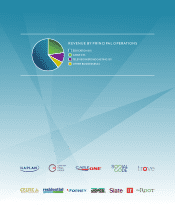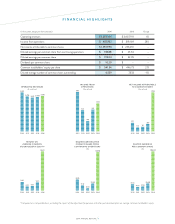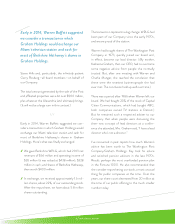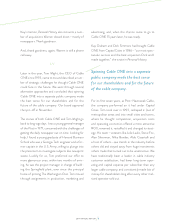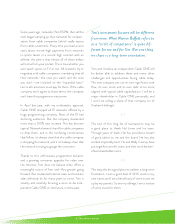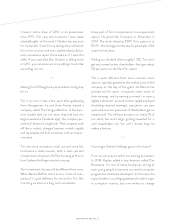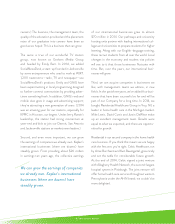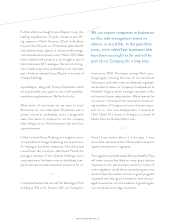Washington Post 2014 Annual Report Download - page 7
Download and view the complete annual report
Please find page 7 of the 2014 Washington Post annual report below. You can navigate through the pages in the report by either clicking on the pages listed below, or by using the keyword search tool below to find specific information within the annual report.
2014 ANNUAL REPORT 5
Kay’s memoir, Personal History, also recounts a num-
ber of acquisitions Warren slowed down—mostly of
newspapers. Thank goodness.
And, thank goodness, again; Warren is still a phone
call away.
/ / /
Later in the year, Tom Might, the CEO of Cable
ONE since 1993, came to me and described a num-
ber of strategic challenges he thought Cable ONE
could face in the future. We went through several
alternative approaches and concluded that spinning
Cable ONE into a separate public company made
the best sense for our shareholders and for the
future of the cable company. Our board approved
the spin-o in November.
The stories of both Cable ONE and Tom Might go
back to long-ago days. I was a young general manager
of the Post in 1977, consumed with the challenges of
getting the daily newspaper out on time. Looking for
help, I found a young graduate of Harvard Business
School who was a Georgia Tech engineer and a for-
mer captain in the U.S. Army, willing to plunge into
the pressroom to investigate subjects like newsprint
waste. Luckily for us, Tom preferred our oer to
more glamorous ones; within two months of arriv-
ing, he was the project manager in charge of build-
ing the Springfield plant, ever since the principal
home of printing The Washington Post. Tom moved
through assignments in production, marketing and
advertising, and, when the chance came to go to
Cable ONE 15 years later, he was ready.
Kay Graham and Dick Simmons had bought Cable
ONE from Capital Cities in 1986—“our most spec-
tacular success and the best acquisition Dick and I
made together,” she wrote in Personal History.
For its first seven years, as Post–Newsweek Cable,
the company performed as it had under Capital
Cities. Tom took over in 1993, reshaped it (out of
metropolitan areas and into small cities and towns,
where he thought competition, acquisition costs
and operating economics oered a more attractive
ROI), renamed it, restaed it and changed its strat-
egy. His team—veterans like Julie Laulis, Steve Fox,
Alan Silverman, Mike Bowker, Aldo Casartelli and
a host of others—saw trends in the industry before
others did and stayed away from huge investments
others made that turned out to be unattractive. We
have traditionally been a leader in cable industry
customer satisfaction; had lower long-term oper-
ating and capital expense per subscriber than any
larger cable company; and consistently made lots of
money for shareholders long after every other mid-
sized operator sold out.
Spinning Cable ONE into a separate
public company made the best sense
for our shareholders and for the future
of the cable company.


